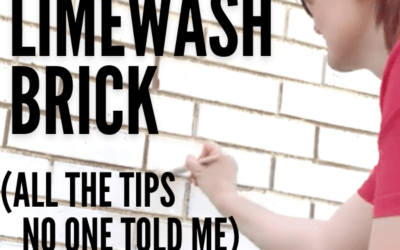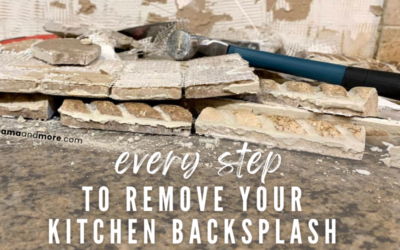Have you ever struggled with reading a tape measure? It’s okay, this is a safe place–you can admit it.
You know that feeling when your measurement hits one of those itty bitty lines? The “how the [bleep] am I supposed to know what fraction that is?!” feeling? That’s what we’re going to talk about in this guide to tape measure markings.
Here’s what we’ll cover:
- Understanding tape measures
- How to read a tape measure (and all those crazy lines)
- Tape measure tips & hacks
Understanding Tape Measures (More Important Than You’d Think)
I know I know–YOU’RE AN ADULT. YOU KNOW WHAT A TAPE MEASURE IS. But in order for us to fully learn how to read measuring tape accurately and EASILY, it’s good to go through the basics.
After all, I was not one of those people who grew up learning handy things. When I go through the basics of DIY things, I almost always learn new things that I probably should have already know.
PSSSST, if you wanna skip the full guide and descriptions of how tape measures work (i.e., you are not nearly as nerdy as me), just go straight to my TAPE MEASURE GUIDE below. This is a printable guide that you can display in your garage or wherever you’re working to help you quickly and accurately read your tape measurements. It includes a guide to help you understand and learn all those smaller marks and special markings.
Related: How to Cut a Straight Line with a Jigsaw or Circular Saw
Metric vs. Imperial Systems
Metric system tape measures use centimeters and millimeters. These tape measures are divided into 10 millimeters for each centimeter mark.
On the other hand, imperial systems use inches and feet, including tape measure fractions. They have inch marks and foot markings and include fractions of an inch, like ½ inch, ¼ inch, ⅛ inch, and even 1/16th inch. The most prominent markings are usually the one half inch and the full inch.
Although many measuring tapes have both imperial units AND metric units, I think we can all agree that the metric markings aren’t nearly as confusing.
AND, even though we all agree that the metric system is simpler, America still mostly uses imperial measurements. So……… here we are. Therefore, most of this tape measure guide will focus on the imperial system–and hopefully making it just a liiiiittle easier to work with.
Essential Parts of a Tape Measure

You probably already know this part without even thinking. The basic parts of a tape measure are:
- Blade: This is the technical term for the long yellow part of it with the markings. What makes a tape measure a tape measure is that this thin material can/show extend pretty far without bending–or with minimal bending.
- Tab hook: This is that little metal piece on the very end of the blade that hooks onto whatever you’re measuring.
- Lock: This is the piece of a tape measure that locks the blade in place when it’s extended.
- Belt clip: This sexy thing?! Obviously to hang your tape measure from your extremely stylish tool belt!
Congratulations! You’ve graduated the Tape Measure Nerd class of Kaylee University. Now we can move on to things that are probably slightly more interesting.
How to Read a Tape Measure (For Real)
Let’s start with a fun story about how NOT to read a tape measure. The way I managed weird measurements for the last 4 years of DIYing was by avoiding fractions completely. Instead, I just made my own Kaylee system that barely even made sense to my own brain.
For example, I’d call this measurement that I made while installing my kitchen backsplash tile “five inches and one.”

And I mean, it worked for me for a while! But those measurements wouldn’t make sense to anyone else if/when I’d work with them. Plus, the ACTUAL problem is that as soon as I looked away, I’d question exactly what I meant by that weird estimation. Thanks a lot, ADHD.
The better solution is to actually learn how to read a tape measure CORRECTLY. Trust me, this is really hard for me to take the 5 minutes to do, too. 😛
So just for you, this next section is a FULL breakdown of how to understand and remember all the tape measure lines and marks that you’ve generally ignored until now.
Reading the Tape Measure Lines & Marks
There are probably hundreds of thousands of different kinds of tape measures on the market, with different lengths, different markings, different sizes, etc, etc. Some have fractions on them, some don’t, some only label the whole inches, some are way too bendy, some are way too expensive, etc etc…

All of that to say that your exact tape measure’s number markings may look different than what you see here, but this should help you understand how to read measuring tape in general.
When you look at the lines on a tape measure, you’ll see:
- Thin lines of slightly different lengths — the longest line typically represents one inch, and the shortest lines typically represent the smallest fractions (usually 1/16th)
- Inch and foot markings — Although every tape measure is different, almost all of them have at least the inches and feet marked with a number
- Special symbols — Like black diamonds and red numbers. These markings are really for construction pros, which you can ABSOLUTELY pretend that you are. 😉 The red markings on a tape measure indicate the standard 16-inch stud placement. Black diamonds, also known as truss marks, are placed every 19 3/16 inches to represent the spacing of l-beam “timbers” on floors. This may not ever be information you need to know, but it could be a trivia question… so…. You’re welcome.
*Fun fact! The technical term for the small lines are “fractional markings,” and they are the lines marking every 1/16th of an inch. (Maybe it wasn’t a fun fact.)
However, there are some tape measures that have even more markings–my smallest tape measure has lines marking 32nds! THIRTY SECONDTHS OF A DANG INCH!!!! Can you believe that?! My brain can’t handle it y’all.
Also, interestingly, many tape measures do some lines labled with fractions, but they usually don’t have the 16ths marked. So, that really doesn’t help me in the heat of the moment when I’m measuring something that’s 9/16ths of an inch and it’s not labeled.
So I drew out this random sign to help me remember. I’ve learned over the years not to fight my own brain, even if it what it needs seems strange. I hope it helps someone else, too:
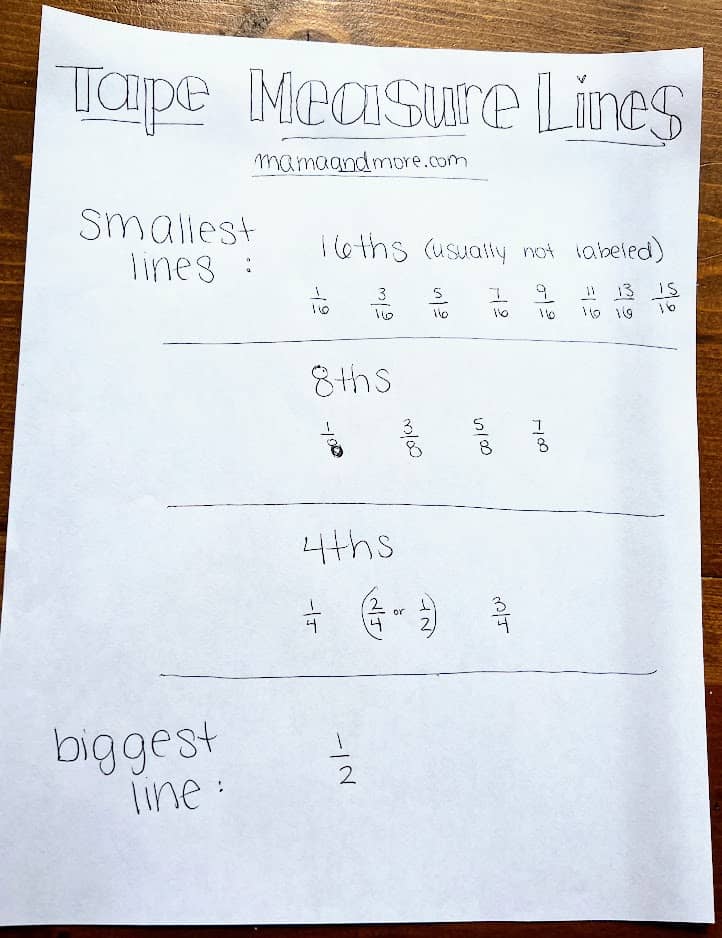
NOW. The other way I’ve continually practiced learning to read the tape measuring and improved is by using a tape measure guide. And yes–I made one for you!
It sounds simple, but I just hang this in the place where I’m usually measuring and cutting things, and it helps me to have an 8.5 by 11 inch paper where I can just look to remember what tiny fraction comes after 5/8ths (ahem, it’s 11/16ths, by the way).
So, I made this printable tape measure guide–and a decimal guide version… and two more versions. Because I’m me and I’m a disaster okay?!
You can get the bundle of measuring tape guides in my prints Etsy shop!
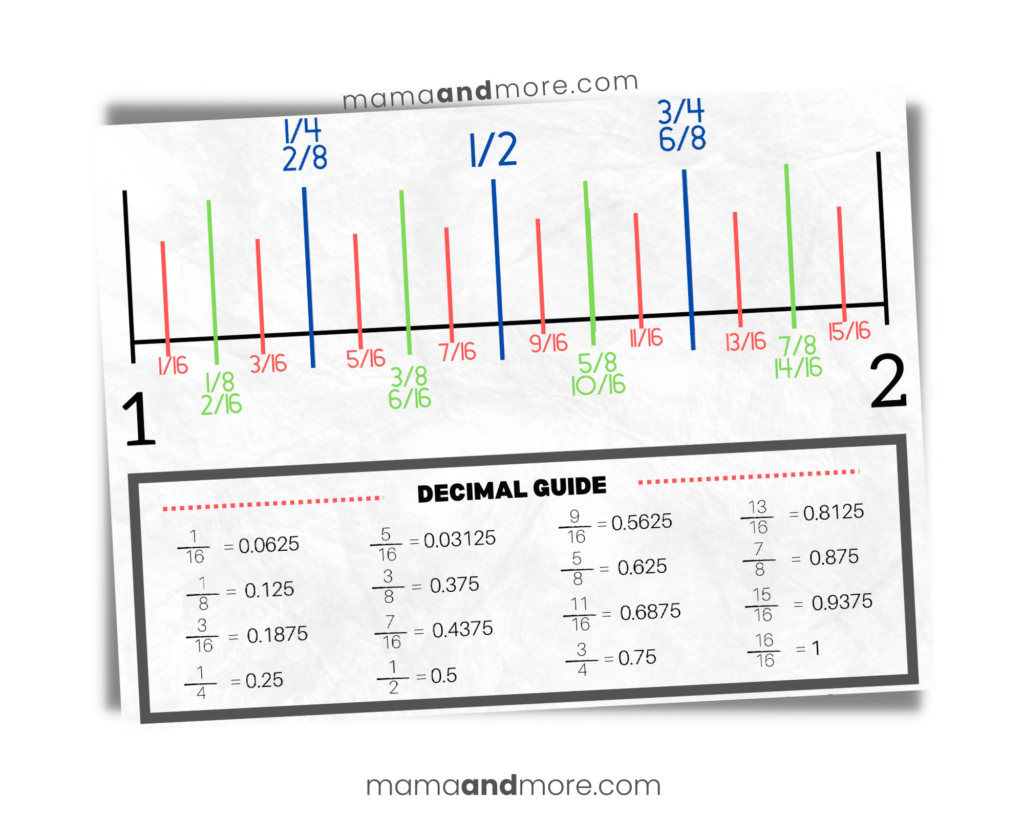
Pssst, want to show off your love for DIY? Check out my product designs I made specifically for DIYers! (and ADHDers… and moms 😉 Visit my Etsy shop Black Door Fits. You can even get 20% off your order!

5 Tape Measure Hacks & Tips
Okay, I wasn’t originally planning on writing this section in this post… but I came across some of these and they honestly blew my mind. I did not realize that the creators of measuring tapes really through through so many design things to make it easy for us…. AND THEY FORGET TO TELL US ABOUT THEM.
*sigh*
Here are 5 tape measure tips that I’m overly excited about:
1. No More Bending the Tape–Tape Measures are Pre-Measured!
You know when you have to take an inside measurement, we all do that thing where we bend the tape measure–I’ve even seen handymen do it. Then we essentially make an educated guess about which of the little lines is actually the exact measurement, because if we’re being honest, it’s really not clear AT ALL.
Yeah… we never had to do that. Because tape measures come with the actual measurement of the tape measure on them! WHAAAAAT.
I even used a second tape measure to check that it was correct.
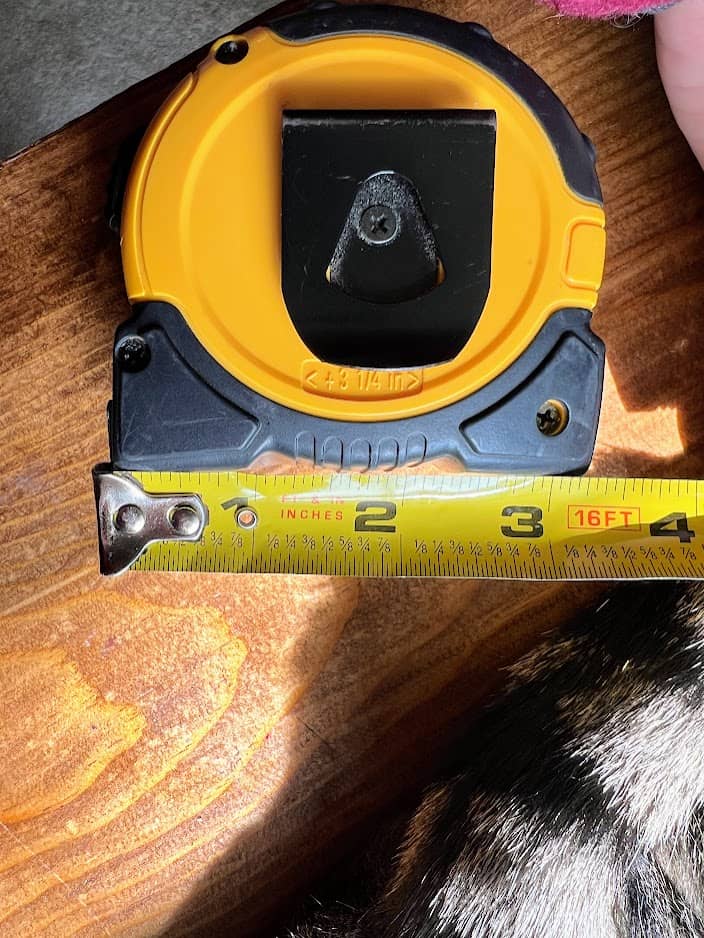
SO, this means that you don’t have to bend the tape anymore! You just have to sit your tape measure in the spot and add its size to get your total
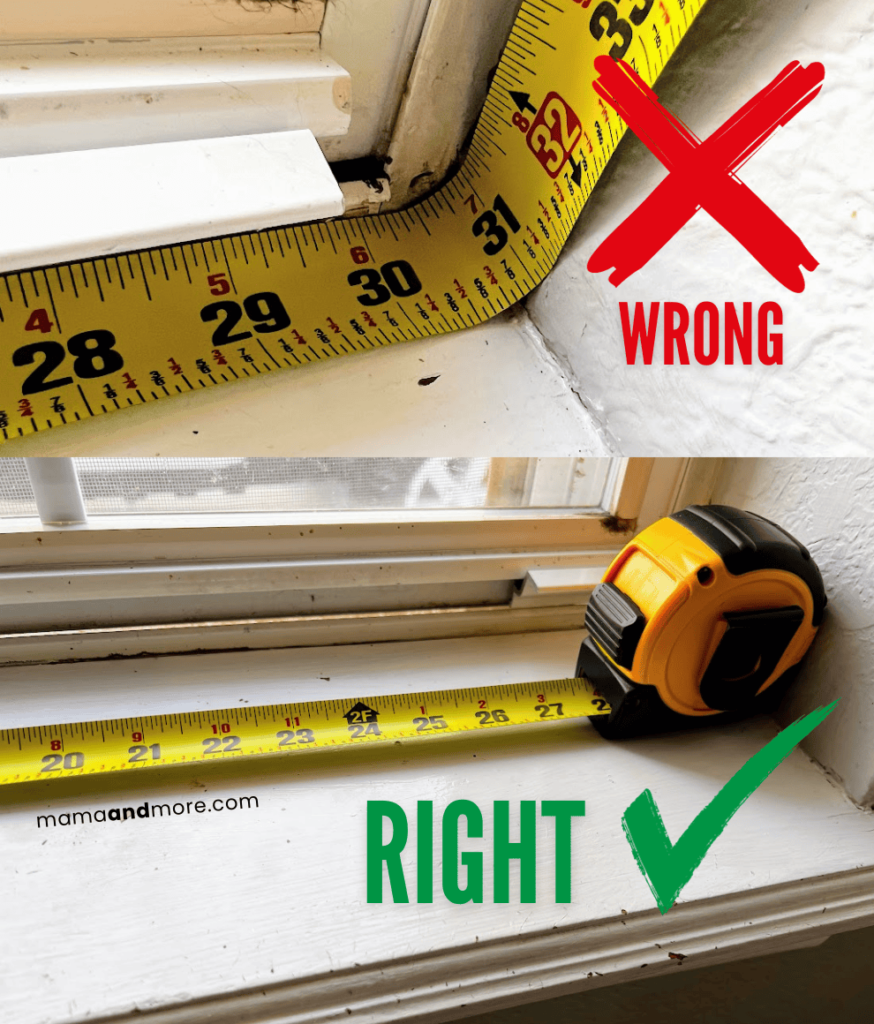
This even gives you a much more accurate measurement! I would have estimated the top photo to be 30 inches and 13/16ths. But the actual measurement, when I did it the right way, is 30 and 15/16ths.
HOW DID I NEVER KNOW THIS. Allllll of my screwed up wood cuts are really starting to make a lot of sense!
Important tip: For weird 16th measurements like this one, decimals are really gonna come in handy. I used the decimal guide that’s already in my measuring tape guide to figure that measurement out.
2. The Wiggly Hook is INTENTIONAL
Obviously, sometimes you don’t need a measurement accurate down to the 16th of an inch–like when you’re measuring a couch or something. But when you’re building something with wood, accuracy is MUY IMPORTANTE. And placing the hook correctly and making the tape straight are key for getting accurate measurements.
For example, having accurate measurements is arguably the most important part of creating a board and batten wall–the rest is easy peasy.

Anyway–did you ever notice that the hook on your measuring tape moves around? Honestly, I didn’t notice this for a long time. But it turns out this is on PURPOSE, and it’s part of a design to give you the most precise reading on inside and outside edges.
It’s because the metal hook (and the space between the tape) actually takes up important space in your measurement.

When you’re making an inside measurement, the hook pushes in. When you’re making an outside measurement (hooking the tab onto something), the hook slides out to account for the size of the actual metal hook.
ISN’T THAT FASCINATING.

3. Easily Measure a Perfect Circle
The hole in the tape measure’s hook is actually a nail notch. This could be useful for some measurements, but is probably most useful to make a perfect circle!
I don’t know about you, but I have avoided circles in my projects because I don’t know how to measure them 😂 Aaaand now we do!
🎶 A whole new woooorld….. 🎶

Related: How to Nail Into Drywall
4. Use the Same Measuring Tape
This one is a personal tip from your favorite chaotic ADHD single mom DIYer. Hi. 🙂
When you’re doing a DIY project, make sure you use the SAME tape measure during the entire project. It’s really handy to have multiple tape measures, but sometimes they can be juuuuust a little inconsistent.
And it really sucks to take accurate measurements and then have inaccurate cuts because of measurement inconsistencies. TRUST ME. I’ve done it.
A lot.
*Ahem* Speaking of, here are a few of my favorite wood projects! I have actually done SO, SO many more, but getting my projects onto the internet takes me approximately 2 years. (That sounds like joke. It’s not.)
- Wrap Porch Posts with Wood
- Easy DIY Cat Climbing Wall
- DIY Floating Rectangle Shelf
- DIY Wood Desktop
- DIY Hanging Fruit Basket

5. Try a Digital Tape Measure
I HOPE that after reading this whole article, you feel like you have a new lease on tape measures.
But if not…. I live in America, there’s a product for everything! They make digital tape measures that will just display the measurement–no brain power involved. I need minimal brain power requirements.
Here are a few I would try–although I don’t actually have them:
- LEXIVON Digital Laser Tape Measure
- Digital Tape Measure – Temu or TikTok
- MiLESEEY Laser Measure Device
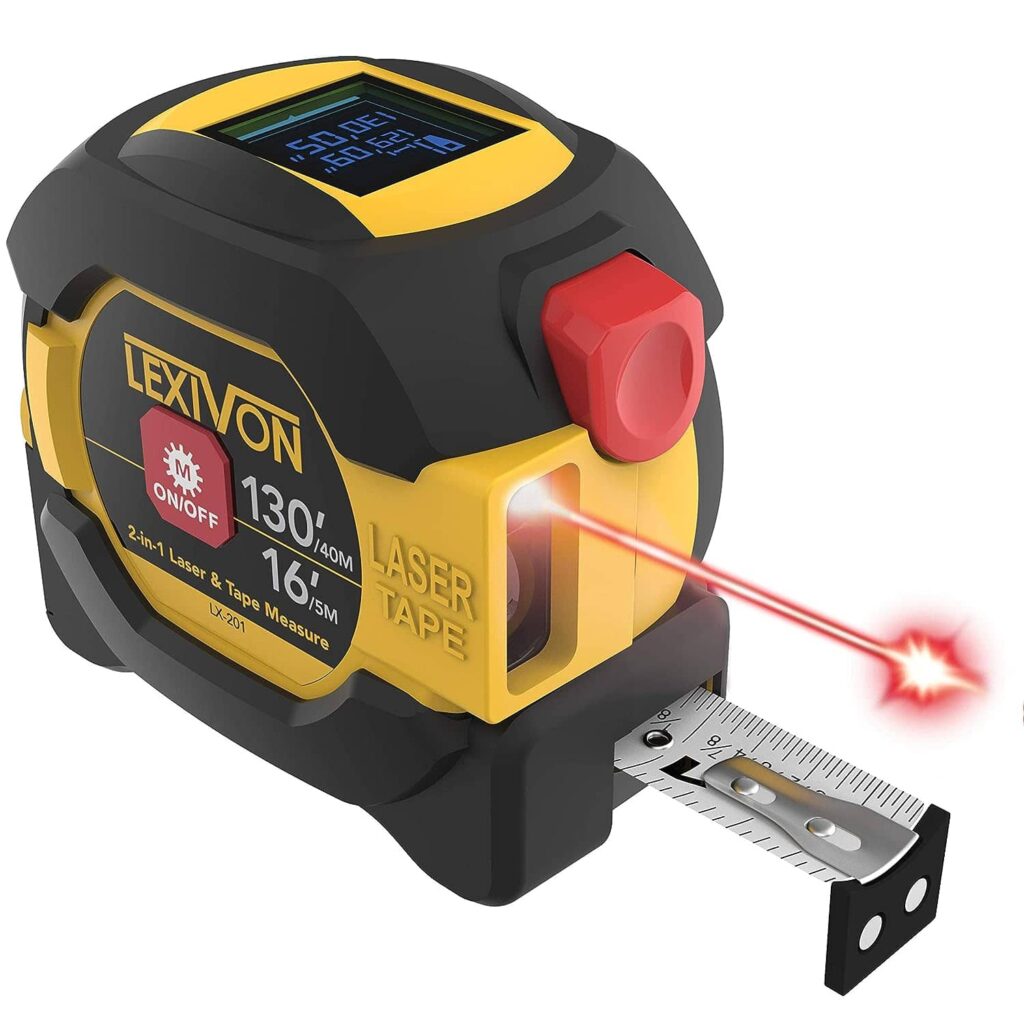
I know I’m just another rando on the internet, but I make a point not to recommend random products if I haven’t tried them. I’m also a very self-taught DIYer, and sometimes I need recommendations from NON-professionals for new tools.
If that’s you, make sure you read and save my Incomplete List of the Best Tools & Supplies for DIY Lovers!
It includes probably TMI about the tools and supplies I’ve used and loved–and I continue to add to it as I do more projects that I don’t really have time for. 🙂
You’re a Tape Measure Reading Pro
Congratulations! Now you know how to read a tape measure and probably lots more things you didn’t know (or didn’t care to know?). I really hope my hours of research on imperial & metric tape measures and all the different inch markings is actually helpful to you.
If you have any other thoughts or questions about reading a tape measure, find me on Instagram or TikTok. I can’t wait to hear from you 🙂
Share this post on Pinterest!




